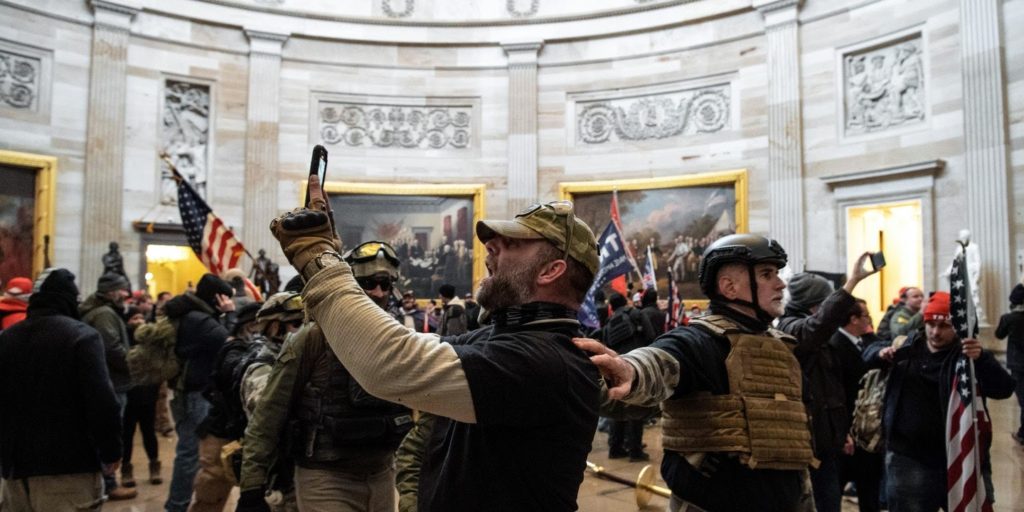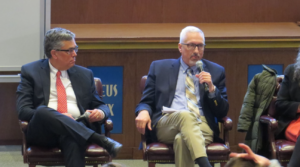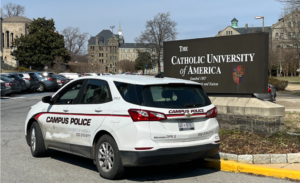Chaos at the Capitol: Extremists Storm Congress During Electoral College Certification

Image Courtesy of The Intercept
By Jeremy Perillo
On the day Congress was mandated by the Constitution to certify the Electoral College votes for the 2020 presidential election, pro-Trump extremists overtook Capitol Police and stormed into the Capitol building. An overwhelmingly pro-Trump mob, having gathered in D.C. to protest the election results, marched to Capitol Hill following “Stop the Steal” rallies and was able to force entry into the building.
The country’s hub of democracy has not faced such a major attack since 1814, when the British army burned down the Capitol building during the War of 1812. The scenes of American citizens bashing in windows and running around the halls of Congress were portrayed across the world, to an utterly shocked audience.
In true mob fashion, these domestic terrorists overwhelmed Capitol Police at every juncture, forcing themselves onto restricted parts of the building. There seemed to be several different components of the event: those who stood by and watched, those who ascended the inauguration bleachers and scaffolding on the west side of the Capitol, those that ascended the stairs leading into the various buildings on the east side, and those who forced themselves into the building itself.
It did not take long for people across the world to see these insurrectionists walking around the halls of Congress, slowly but surely taking over the building. Once inside, rioters continued to clash with police and vandalize property.
Even though the nation’s legislative body was being overrun, which is no dismissable feat, the events of January 6 also posed a threat to the continuity of government. Three of the officials behind the president in the line of succession were in the Capitol: Vice President Pence, Speaker Pelosi, and President Pro Tempore Chuck Grassley. Vice President-elect Kamala Harris was also on the premises.
Those present make the breach of the Senate chambers even more remarkable. After Pence and the senators had been evacuated, members of the mob briefly took control of the chamber, taking pictures on the dais, congregating in the gallery, and sitting on desks on the floor.
On the other side of the building, with House members still locked inside, security personnel barricaded the door to the chambers and engaged in an armed standoff as the mob tried to enter the chamber.
One woman was killed by police while trying to enter the House chamber, and three other individuals died from medical emergencies. Dozens of police officers suffered injuries from their clashes with the rioters.
It is not abundantly clear how such a thing could happen to one of the (supposedly) most secure buildings in the country. Videos surfaced on social media of protestors pulling down fencing, fighting with severely outnumbered police officers, and in one instance, Capitol police officers allowing rioters to walk into restricted areas outside the building. Many have drawn comparisons to the response, or the lack thereof, between this event and the Black Lives Matter protests that occurred in the nation’s capital over the summer. Overall, however, it seems that the authorities simply were not prepared for what took place, an obvious misjudgment from individuals whose job is to prepare for the worst.
Already, in the day following the riot, the Capitol Police Chief, Steven Sund resigned from his role. Late Thursday, a day after the events transpired, Speaker Pelosi announced that House Sergeant-at-Arms, Paul Irving, had submitted his resignation. Further, Senate Minority Leader Chuck Schumer stated similarly that if the Senate Sergeant-at-Arms had not resigned by the time the Democrats became a majority, Schumer would fire him.
Congress reconvened after the building was cleared by law enforcement, and each chamber continued its debate on the objection to Arizona’s electors, which failed in both houses. Congress later went through debates on objections to Pennsylvania’s electors, and the mood amongst Republicans seemed to change.
Senator Kelly Loeffler, recently defeated in her re-election bid against Rev. Raphael Warnock, changed her stance on objecting to electors after the riot.
“When I arrived in Washington this morning, I fully intended to object to the certification of the electoral votes,” she said. “However, the events that have transpired today have forced me to reconsider and I cannot now in good conscience object to the certification of these electors.”
Loeffler was one of Trump’s most ardent allies on the issue of alleged voter fraud, so much so that it remained a focal point of her re-election campaign.
Senator Lindsey Graham, another close ally of Trump, also surprised many for refusing to object to electors. Still one of the President’s most loyal policy supporters, Graham articulated to reporters on January 7 that all of Trump’s accomplishments were “tarnished” by Wednesday’s events.
“When it comes to accountability, the President needs to understand that his actions were the problem, not the solution,” he said. “The rally yesterday was unseemly and got out of hand…there has been a constant effort by people from the President’s legal team to provide misinformation, to distort the facts, to make accusations that cannot be proven – that needs to stop.”
Trump’s Deputy National Security Advisor, the chief of staff for First Lady Melania Trump, the White House Deputy Press Secretary, and the White House Social Secretary all resigned the day of the storming. Mick Mulvaney, Trump’s former chief of staff and the special envoy to Northern Ireland, resigned the following day.
As of the publication of this article, there have been two members of Trump’s cabinet who have resigned: Elaine Chao, Transportation Secretary and wife of Mitch McConnell, and Betsy DeVos, Secretary of Education. Both resigned on January 7.
Unsurprisingly, the Pennsylvania objection failed in both houses, and at 3:41 am on January 7, 2021, Vice President Mike Pence declared that Joe Biden and Kamala Harris would take office on January 20.
As America continues to process the insurrection that occurred in the nation’s capital, it is clear that introspection is occurring at all levels of government about rhetoric, disinformation, and the importance of preserving republican institutions. In the coming weeks, America will be enduring a peaceful transition of power, the likes of which have been experienced since the founding of this country. Those who sought to disrupt such a transition, from the inflammatory politicians to the rioters running through the halls of Congress, will be subject to justice and be held responsible for their role in such a subversion.





